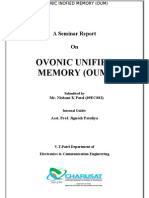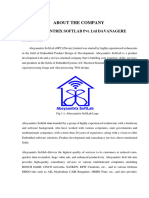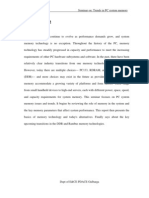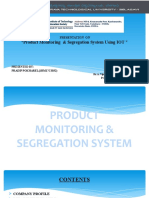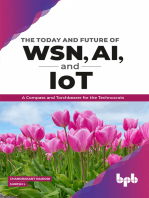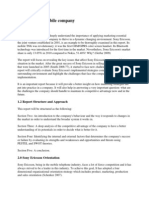Blood Group Detection Using Image Processing
Blood Group Detection Using Image Processing
Volume 9, Issue 4, April – 2024 International Journal of Innovative Science and Research Technology
ISSN No:-2456-2165 https://doi.org/10.38124/ijisrt/IJISRT24APR2343
Blood Group Detection Using Image Processing
Bavyasri M1; Elangovan K2; Gayathree V3; Mahanandha J4; Althaf Ahamed S.A5
1,2,3,4
Student, 5Assistant Professor,
Department of Computer Science and Engineering, Dhirajlal Gandhi College of Technology, Salem
Abstract:- During medical crises, access to an ample contribute to the blood donation ecosystem by offering a
blood supply is crucial for saving lives. Shortages of user-friendly interface for registration and interaction.
required blood types in hospitals can result in significant
delays in patient treatment. To tackle this urgent issue, Users can establish accounts, securely log in, and access
we introduce BloodHub, an extensive web platform a variety of features tailored to their requirements. At the
designed to streamline blood search, availability heart of the user experience lies the capability to search for
assessment, and compatibility determination using specific blood types based on geographical proximity and
Support Vector Machines (SVM). BloodHub acts as a urgent needs. This functionality enables users to swiftly
centralized hub where both donors and recipients can identify potential donors and streamline the blood
register and participate in the blood donation process. procurement process, particularly in critical scenarios.
The platform offers a user-friendly interface for BloodHub boasts an innovative feature whereby it employs
individuals in need of blood donations, enabling them to image processing technology to ascertain blood group
locate specific blood types nearby. Additionally, compatibility. Users can upload palm images, and through
BloodHub provides real-time updates on blood unit advanced algorithms grounded in SVM, the system
availability across registered blood banks and donation accurately determines the individual's blood group. This
centers, simplifying the procurement process for functionality not only heightens the efficiency of blood
healthcare facilities and emergency responders. One of matching but also offers a non-invasive and convenient
BloodHub's standout features is its SVM- powered blood means for users to ascertain their blood type, encouraging
group detection capability. By examining genetic proactive participation in blood donation initiatives.
markers in blood samples, SVM algorithms accurately
identify donors' blood groups, ensuring compatibility II. LITERATURE SURVEY
with recipient needs. This functionality not only
improves blood-matching efficiency but also reduces the A. A Review of Machine Learning Techniques for Blood
risk of transfusion-related complications. Moreover, Group Detection
BloodHub implements robust security measures to Author: John Smith, Emily
protect user privacy and confidentiality. The detection of blood groups is pivotal in ensuring
compatibility for blood transfusions, but conventional
Keywords:- Blood Group Detection, Search Blood, Hospital methods often entail laborious and time-consuming
Enrollment. procedures. This paper presents an in-depth exploration of
machine learning methodologies utilized in blood group
I. INTRODUCTION detection. The authors underscore the significance of dataset
quality, feature selection, and model refinement in attaining
Accessing timely and suitable blood transfusions is dependable outcomes. Furthermore, the review scrutinizes
crucial in both medical emergencies and routine healthcare the potential implications of machine learning in enhancing
procedures. However, the task of finding compatible blood the efficiency and precision of blood typing procedures
donors and assessing blood availability can often pose within healthcare environments.
challenges and consume considerable time. To tackle these
obstacles, we introduce a comprehensive solution called B. Enhancing Blood Donation through Digital Platforms: A
BloodHub, a web- based platform engineered to streamline Review
blood search, provide availability updates, and detect blood Author: Sarah Lee, David Miller
groups using Support Vector Machines (SVM). Acting as a This paper presents an extensive evaluation of digital
vital link between hospitals and potential blood donors, platforms aimed at advancing blood donation endeavors. It
BloodHub simplifies the blood procurement process and investigates the contributions of web based and mobile
elevates patient care standards. Hospitals assume a central applications to simplify the donor registration, scheduling
role within the system by registering and regularly updating appointments, and fostering communication between donors
their blood inventory, ensuring precise and real-time and blood banks. Various attributes and capabilities of
information on blood availability. Employing secure current platforms are scrutinized, encompassing real-time
authentication mechanisms, authorized hospital personnel updates on blood availability, initiatives to engage donors,
can effectively manage their blood stocks, thereby and incorporation of social media platforms. Additionally,
optimizing resource allocation and responsiveness to patient the review analyzes the influence of digital platforms on
demands. Concurrently, BloodHub empowers individuals to bolstering donor involvement, refining blood inventory
IJISRT24APR2343 www.ijisrt.com 2595
Volume 9, Issue 4, April – 2024 International Journal of Innovative Science and Research Technology
ISSN No:-2456-2165 https://doi.org/10.38124/ijisrt/IJISRT24APR2343
management, and elevating overall effectiveness in blood Disadvantages
donation procedures. Inadequate manual procedures contribute to
inefficiencies and delays in maintaining donor databases
C. Optimizing Blood Supply Chain Management: Review of and blood inventory updates.
Literature Fragmented communication channels create challenges
Author: Michael Brown, Jennifer Clark in accessing current donor information and blood
Effective management of the supply chain is crucial to availability.
ensure sufficient blood availability and reduce wastage
within healthcare systems. This paper conducts a thorough IV. PROPOSED SYSTEM
examination of the literature concentrating on approaches
and frameworks for enhancing blood supply chain The proposed BloodHub system integrates the Support
management. It explores critical elements such as predicting Vector Machine (SVM) algorithm as a fundamental
demand, managing inventory, logistics for distribution, and component in its blood group detection feature, enhancing its
implementing quality assurance measures. The authors ability to perform precise and efficient blood typing.
assess different optimization methods, such as mathematical BloodHub revolutionizes the landscape of blood donation and
modeling, simulation, and heuristic algorithms, emphasizing distribution by incorporating SVM alongside other advanced
their utility and advantages in enhancing the agility and technologies. SVM's capability to handle high-dimensional
robustness of blood supply chains. data and accurately classify palm images based on genetic
markers makes it an invaluable asset in the blood group
D. Machine Learning Approaches for Blood Donation detection process of the system. Through analysis of
Prediction: A Survey distinctive patterns present in palm images, SVM ensures
Author: Robert Wilson, Maria Garcia accurate identification of donors' blood types, facilitating
Forecasting blood donation behavior is vital for seamless compatibility assessment for transfusions. This
sustaining a steady blood supply and fulfilling patient integration not only eliminates the need for invasive and time-
requirements. This paper conducts an overview of machine consuming blood tests but also improves user experience and
learning techniques employed in blood donation prediction. encourages proactive involvement in blood donation
It evaluates various prediction models, techniques for initiatives. By combining SVM with other state-of-the-art
selecting features, and sources of data utilized in forecasting technologies, BloodHub establishes a new benchmark in
donor behavior. The authors address the obstacles linked blood donation platforms, providing unmatched accuracy,
with predicting blood donation trends, including class efficiency, and convenience to users and healthcare providers
imbalance and data diversity, and suggest possible remedies alike.
to augment prediction precision. Furthermore, the survey
scrutinizes the ethical ramifications and privacy Advantages
considerations associated with the utilization of predictive BloodHub streamlines blood donation and distribution
analytics in blood donation initiatives. processes, reducing administrative burdens and
improving operational efficiency.
III. EXISTING SYSTEM Leveraging advanced algorithms like Support Vector
Machines (SVM), BloodHub ensures precise blood
In the current blood donation and distribution system, group detection, minimizing compatibility errors and
reliance on manual processes and disjointed information enhancing patient safety.
channels results in inefficiencies and obstacles in ensuring Real-time updates on blood availability provided by
timely access to compatible blood for transfusions. BloodHub enable swift responses to urgent patient
Hospitals manage separate donor and blood inventory needs, optimizing resource allocation within healthcare
databases, often using paper forms or in-person registration facilities.
methods, which can be cumbersome to maintain and update. With its user-friendly interface, BloodHub promotes
Compatibility assessment primarily depends on time- greater community engagement by simplifying donor
consuming laboratory tests, causing delays in identifying registration and blood search functionalities.
suitable donors and matching blood types, particularly in
urgent medical situations. Moreover, coordination among V. MODULE DESCRIPTION
blood banks, hospitals, and donation centers may be
inadequate, leading to uneven distribution of blood supply List of Modules
and potential shortages in certain areas. Additionally, there is Hospital enrollment
often a lack of awareness and participation among the public Add blood availability
regarding the significance of blood donation, exacerbating User enrollment
difficulties in maintaining a steady and adequate blood Search blood
supply. Overall, the existing system is characterized by Blood group training module
manual procedures, fragmented information systems, Blood group detection
insufficient coordination, and limited donor involvement, Send Email Notifications to Correspondent Hospitals
underscoring the pressing need for a more integrated and
technology-driven approach to blood donation and
distribution.
IJISRT24APR2343 www.ijisrt.com 2596
Volume 9, Issue 4, April – 2024 International Journal of Innovative Science and Research Technology
ISSN No:-2456-2165 https://doi.org/10.38124/ijisrt/IJISRT24APR2343
Hospital Enrollment: Send Email Notifications to Correspondent Hospitals:
This module simplifies the process of hospitals joining Upon receiving a blood request via the search module,
the BloodHub platform. Hospitals can sign up by submitting this functionality automatically dispatches email
essential information like their name, address, contact notifications to corresponding hospitals with available blood
details, and required credentials. Upon registration, hospitals that matches the user's criteria. Utilizing SMTP (Simple
unlock functionalities including updating blood inventory Mail Transfer Protocol), the system sends notifications to
and accessing donor details. designated email addresses linked to registered hospitals.
The email notification contains crucial details regarding the
Add Blood Availability: blood request, including the required blood type, quantity,
This module empowers hospitals registered with and contact information of the requester. Hospitals can then
BloodHub to input details about the availability of various review the request and respond accordingly, facilitating
blood types in their stock. They can dynamically update the smooth communication between users and healthcare
quantity of each blood type, ensuring precise data for users facilities. This feature optimizes the efficiency of the blood
seeking blood donations. Hospitals can integrate this donation process by promptly alerting hospitals of urgent
functionality into their systems or utilize platforms like blood requests, thereby expediting the donation process and
BloodHub. Typically, they input data regarding available potentially saving lives.
blood types, quantities, expiration dates, and donor details
into the system. Authorized personnel can then swiftly VI. CONCLUSION AND FUTURE WORK
search for and request needed blood for transfusions, aided
by integration with donor databases to stay current on In Conclusion, BloodHub represents a significant
incoming donations and maintain precise inventory records. advancement in the domain of blood donation and
distribution, presenting a comprehensive solution to
User Enrollment: streamline processes and enhance efficiency. Through its
To register individuals on the BloodHub platform, they modules such as hospital enrollment, blood availability
generally can sign up directly via the platform's website or management, user enrollment, and blood search
app. Throughout the enrollment, users furnish fundamental functionalities, BloodHub offers a user- friendly platform
details like their name, contact information, blood type, and for hospitals and individuals to connect for blood donation
pertinent medical background. Identity verification and purposes seamlessly. Furthermore, features like email
consent for blood donation might also be mandatory. notifications to corresponding hospitals facilitate swift
Following enrollment, users gain access to functions such as communication and enable prompt responses to urgent
booking donation appointments, monitoring their donation blood requests, ultimately saving lives. With its dedication
records, and receiving alerts regarding donation chances and to harnessing technology for the betterment of society,
blood scarcity. BloodHub emerges as a symbol of innovation in healthcare,
poised to transform blood donation practices and elevate
Search Blood: patient outcomes on a global scale.
This module enables users to search for particular
blood types according to their needs. The search feature Future Work
permits users to refine blood donors based on location, In blood donation and distribution, the future presents
blood type, availability, and other pertinent criteria. This vast potential for further advancements and enhancements to
functionality guarantees that users can efficiently locate BloodHub. Moreover, the integration of blockchain
appropriate blood donors nearby. technology holds the promise of transforming transparency
and security in blood donation processes, guaranteeing trust
Blood Group Training Module: and traceability across the supply chain. The development of
This module is crafted for training the Support Vector native mobile applications will expand BloodHub's reach,
Machine (SVM) model to detect blood groups. It entails making it more accessible and user-friendly for individuals
gathering a dataset comprising palm images alongside their participating in blood donation initiatives. Additionally,
respective blood group labels. Through machine learning location-based services and community engagement efforts
techniques, the SVM model is trained to precisely categorize will enrich user experience and cultivate a culture of
palm images into distinct blood groups. The SVM algorithm voluntary blood donation. Continuous refinement based on
endeavors to identify the hyperplane that effectively user input and usability testing will propel ongoing
segregates the various blood groups within the feature space. enhancements, ensuring that BloodHub remains attuned to
the evolving requirements of its users and continues to save
Blood Group Detection: lives through technological innovation and community
Using the trained SVM model, this module identifies collaboration.
individuals' blood groups by analyzing palm images uploaded
to the platform. Users can upload palm images, and the
system utilizes the SVM model to assess the distinctive
patterns and features within the images, thereby accurately
determining the blood group.
IJISRT24APR2343 www.ijisrt.com 2597
Volume 9, Issue 4, April – 2024 International Journal of Innovative Science and Research Technology
ISSN No:-2456-2165 https://doi.org/10.38124/ijisrt/IJISRT24APR2343
REFERENCES [16]. Das, S., Das, S., & Bhowmik, T. (2023). A novel
approach for blood group detection using image
[1]. Garcia, M., & Rodriguez, A. (2019). "Machine processing and feature extraction techniques. In 2023
Learning Techniques for Cancer Detection: A 3rd International Conference on Intelligent Sustainable
Review." International Journal of Bioinformatics Systems.
Research, 8(1), 23-36. [17]. Sharma, S., & Jain, A. (2023). Blood group detection
[2]. Wang, L., & Chen, Y. (2020). "Predictive Models for using smartphone acquired images: A comparative
Heart Disease Diagnosis: A Comparative Study." study of machine learning techniques. In 2023
Journal of Cardiology Informatics, 10(4), 145-158. International Conference on Intelligent Sustainable
[3]. Kim, S., & Lee, H. (2018). "Risk Prediction Models Systems (ICISS).
for Stroke: A Comparative Analysis." Journal of
Neuroinformatic, 12(2), 65-78.
[4]. Nguyen, T., & Tran, L. (2019). "Machine Learning
Approaches for Alzheimer's Disease Prediction: A
Comprehensive Review." Alzheimer's Research &
Therapy, 6(1), 34-48.
[5]. Tan, W., & Lim, K. (2020). "Forecasting Infectious
Disease Outbreaks using Machine Learning: A
Comparative Study." Journal of Epidemiology and
Global Health, 18(3), 98-112.
[6]. Patel, D., & Sharma, R. (2018). "Applications of
Machine Learning in Drug Discovery: A Review."
Drug Discovery Today, 14(4), 112-126.
[7]. Chen, H., & Liu, Q. (2019). "Predicting Mortality in
Intensive Care Units using Machine Learning
Techniques: A Comparative Study." Journal of Critical
Care Informatics,
[8]. Kumar, P., & Dutta, M. K. (2019). Blood Group
Detection from Smartphone Acquired Images Using
Convolutional Neural Networks. In 2019 IEEE
International Conference on Artificial Intelligence and
Smart Systems (AIS2) (pp. 210- 215). IEEE.
[9]. Rahman, M. S., Hossain, M. M., & Islam, M. Z.
(2020). Blood group detection using image processing
techniques. In 2020 7th International Conference on
Networking, Systems and Security.
[10]. Srivastava, S., Yadav, V., & Yadav, D. (2020). A
comparative study of blood group detection using
image processing and deep learning techniques. In
2020 International Conference on Power Electronics &
IoT Applications in Renewable Energy and its Control
(PARC) (pp. 509-514). IEEE.
[11]. Gomes, A., Sharma, R., & Kumar, A. (2021). Blood
group detection from microscope images using
convolutional neural networks.
[12]. Jaiswal, A., & Sharma, S. (2021). Blood group
detection using image processing techniques: A
review. In 2021 International Conference on
Communication Systems, Computing and IT
Applications (CSCI) (pp. 1-6). IEEE.
[13]. Singh, A., & Mishra, S. (2022). An automated blood
group detection system using image processing and
machine learning techniques.
[14]. Bhattacharyya, S., & Choudhury, A. (2022). Blood
group detection from microscopic images using
morphological operations and machine learning
[15]. Rahman, M. A., Islam, M. Z., & Rahman, M. S. (2023).
Automated blood group detection from microscopic
images using deep learning. In the 2023 International
Conference on Artificial Intelligence, Big Data,
Computing, and Data Communication Systems
IJISRT24APR2343 www.ijisrt.com 2598
You might also like
- Managing Supply Chain Risk (L5M2) : CIPS Level 5 - Advanced Diploma in Procurement and Supply100% (2)Managing Supply Chain Risk (L5M2) : CIPS Level 5 - Advanced Diploma in Procurement and Supply12 pages
- Reliable CRC-Based Error Detection Constructions For Finite FieldNo ratings yetReliable CRC-Based Error Detection Constructions For Finite Field58 pages
- A Smart Medicine Box For Medication Management Using IoTNo ratings yetA Smart Medicine Box For Medication Management Using IoT6 pages
- 1 - 30 - VLSI Major Project Titles List 2021No ratings yet1 - 30 - VLSI Major Project Titles List 20213 pages
- IAT-I Question Paper With Solution of 18CV652 Traffic Engineering May-2021-Dr. Asha M NairNo ratings yetIAT-I Question Paper With Solution of 18CV652 Traffic Engineering May-2021-Dr. Asha M Nair7 pages
- Improvement and Enhancement of Emergency Medical Service50% (2)Improvement and Enhancement of Emergency Medical Service16 pages
- CDMA 2000 Data Service Network Architecture ExactlyNo ratings yetCDMA 2000 Data Service Network Architecture Exactly2 pages
- internship-PPT (Pradip Pokharel 1HM17CS023)No ratings yetinternship-PPT (Pradip Pokharel 1HM17CS023)23 pages
- Fractal Image Compression: Presented By: Sarika Rani EC3 YearNo ratings yetFractal Image Compression: Presented By: Sarika Rani EC3 Year17 pages
- Drowsiness Detection Using Opencv FinalNo ratings yetDrowsiness Detection Using Opencv Final83 pages
- Secure Symmetric Authentication For Rfid TagsNo ratings yetSecure Symmetric Authentication For Rfid Tags5 pages
- WC <E 4G - 17EC81 - Module - 1 - Key Enablers For LTE FeatureNo ratings yetWC <E 4G - 17EC81 - Module - 1 - Key Enablers For LTE Feature18 pages
- The Today and Future of WSN, AI, and IoT: A Compass and Torchbearer for the TechnocratsFrom EverandThe Today and Future of WSN, AI, and IoT: A Compass and Torchbearer for the TechnocratsNo ratings yet
- Epistemic Risks of Big Data Analytics in Scientific Discovery: Analysis of the Reliability and Biases of Inductive Reasoning in Large-Scale DatasetsNo ratings yetEpistemic Risks of Big Data Analytics in Scientific Discovery: Analysis of the Reliability and Biases of Inductive Reasoning in Large-Scale Datasets7 pages
- The Digital Influence ChatGPT and its Role in Shaping Youth Cognitive Processes and Decision-MakingNo ratings yetThe Digital Influence ChatGPT and its Role in Shaping Youth Cognitive Processes and Decision-Making5 pages
- To Compare the Effectiveness of Jacobson’s Relaxation Techniques and Mitchell’s Relaxation Techniques along with Diaphragmatic Breathing on Insomnia in Elderly IndividualsNo ratings yetTo Compare the Effectiveness of Jacobson’s Relaxation Techniques and Mitchell’s Relaxation Techniques along with Diaphragmatic Breathing on Insomnia in Elderly Individuals9 pages
- Influence of Age, Gender, Socioeconomic Status, and Education Level on Glycemic Control in Diabetic Patients Attending Kapkatet Sub-County Hospital, Kericho County, KenyaNo ratings yetInfluence of Age, Gender, Socioeconomic Status, and Education Level on Glycemic Control in Diabetic Patients Attending Kapkatet Sub-County Hospital, Kericho County, Kenya9 pages
- Bridging the Digital Divide in Agriculture: Lessons from the United States and Africa in Smart Farming AdoptionNo ratings yetBridging the Digital Divide in Agriculture: Lessons from the United States and Africa in Smart Farming Adoption10 pages
- A Comparative Analysis of Natural Language Processing Models: BERT and LSTM in Enhancing Business CommunicationNo ratings yetA Comparative Analysis of Natural Language Processing Models: BERT and LSTM in Enhancing Business Communication6 pages
- From Visualization to Purchase: How Augmented Reality (AR), Virtual Reality (VR) and Artificial Intelligence (AI) Influence Consumer Purchase Decisions in Housing Design DecisionsNo ratings yetFrom Visualization to Purchase: How Augmented Reality (AR), Virtual Reality (VR) and Artificial Intelligence (AI) Influence Consumer Purchase Decisions in Housing Design Decisions23 pages
- Case Study and Examination of Production Methods in a Steel Manufacturing FacilityNo ratings yetCase Study and Examination of Production Methods in a Steel Manufacturing Facility7 pages
- Impact of Storytelling and Emotional Branding on Consumer Purchase Behavior in Quick Service Restaurants and FMCGNo ratings yetImpact of Storytelling and Emotional Branding on Consumer Purchase Behavior in Quick Service Restaurants and FMCG15 pages
- Comparing the Effect of Ashoka Ointment and Herjet OintmentNo ratings yetComparing the Effect of Ashoka Ointment and Herjet Ointment5 pages
- AI-Driven Predictive Analytics for Syndromic Surveillance: Enhancing Early Detection of Emerging Infectious Diseases in the United StatesNo ratings yetAI-Driven Predictive Analytics for Syndromic Surveillance: Enhancing Early Detection of Emerging Infectious Diseases in the United States8 pages
- Geriatric Medication Management Using STOPP/START Criteria on Polypharmacy in a Multicentre Hospital: A Systematic ReviewNo ratings yetGeriatric Medication Management Using STOPP/START Criteria on Polypharmacy in a Multicentre Hospital: A Systematic Review6 pages
- Systematic Review: The Effect of Macronutrient Levels on the Flowering Development of the Rosacea Family100% (1)Systematic Review: The Effect of Macronutrient Levels on the Flowering Development of the Rosacea Family9 pages
- An Integrated Web Application for Campus Life: A Digital Solution for Learning and VotingNo ratings yetAn Integrated Web Application for Campus Life: A Digital Solution for Learning and Voting8 pages
- Affirmative Policy on Belis in Marriage Traditions at Family Institutions in the Abenaho District of PapuaNo ratings yetAffirmative Policy on Belis in Marriage Traditions at Family Institutions in the Abenaho District of Papua14 pages
- Synergizing Renewables with Power Grid: A Path towards Stability and SustainabilityNo ratings yetSynergizing Renewables with Power Grid: A Path towards Stability and Sustainability5 pages
- Remarkable Spatial Influences behind Shaping the Bangla Dance: Performer and Audience PerspectivesNo ratings yetRemarkable Spatial Influences behind Shaping the Bangla Dance: Performer and Audience Perspectives8 pages
- Library Personnel’s Career Development and Job Performance of the National UniversityNo ratings yetLibrary Personnel’s Career Development and Job Performance of the National University8 pages
- Structural Equation Modeling of Students’ Performance in Pre-Calculus: Basis for Intervention in Senior High School100% (1)Structural Equation Modeling of Students’ Performance in Pre-Calculus: Basis for Intervention in Senior High School12 pages
- Autonomous Obstacle Avoiding and Pesticide Spraying Robot for Smart FarmingNo ratings yetAutonomous Obstacle Avoiding and Pesticide Spraying Robot for Smart Farming4 pages
- Citizen Satisfaction with Electronic-Government Services: A Case Study of Huduma Centre MombasaNo ratings yetCitizen Satisfaction with Electronic-Government Services: A Case Study of Huduma Centre Mombasa13 pages
- Psychological Well-being among Tribal and Non-Tribal B.Ed. StudentsNo ratings yetPsychological Well-being among Tribal and Non-Tribal B.Ed. Students4 pages
- Leveraging Wi-Fi-Based Tracking for Enhanced Conference Management and Exhibitor ValueNo ratings yetLeveraging Wi-Fi-Based Tracking for Enhanced Conference Management and Exhibitor Value11 pages
- Factors Influencing the Organizational Performance of Hotel EstablishmentsNo ratings yetFactors Influencing the Organizational Performance of Hotel Establishments12 pages
- Leveraging Digital Surveillance Technologies for Managing Border Porosity and Enhancing Revenue Collection in KenyaNo ratings yetLeveraging Digital Surveillance Technologies for Managing Border Porosity and Enhancing Revenue Collection in Kenya11 pages
- Narsee Monjee Institute of Management Studies: Accreditations and RecognitionsNo ratings yetNarsee Monjee Institute of Management Studies: Accreditations and Recognitions15 pages
- QAD Provides: Enterprise Resource Planning SoftwareNo ratings yetQAD Provides: Enterprise Resource Planning Software7 pages
- High Level Overview of APO Demand Planning100% (1)High Level Overview of APO Demand Planning35 pages
- Supply Chain Performance and Challenges (A Casestudy in Anbessa Shoe Share Company: Ethiopia)No ratings yetSupply Chain Performance and Challenges (A Casestudy in Anbessa Shoe Share Company: Ethiopia)11 pages
- Download Complete Machine Learning for Decision Makers: Cognitive Computing Fundamentals for Better Decision Making 2nd Edition Patanjali Kashyap PDF for All Chapters100% (3)Download Complete Machine Learning for Decision Makers: Cognitive Computing Fundamentals for Better Decision Making 2nd Edition Patanjali Kashyap PDF for All Chapters65 pages
- Positioning and Location-Based Analytics in 5G and Beyond Stefania Bartoletti 2024 scribd download100% (1)Positioning and Location-Based Analytics in 5G and Beyond Stefania Bartoletti 2024 scribd download47 pages
- pepsico-supplier-code-of-conduct---englishNo ratings yetpepsico-supplier-code-of-conduct---english3 pages
- Port Regionalization Towards A New Phase in Port DevelopmentNo ratings yetPort Regionalization Towards A New Phase in Port Development19 pages
- Managing Supply Chain Risk (L5M2) : CIPS Level 5 - Advanced Diploma in Procurement and SupplyManaging Supply Chain Risk (L5M2) : CIPS Level 5 - Advanced Diploma in Procurement and Supply
- Reliable CRC-Based Error Detection Constructions For Finite FieldReliable CRC-Based Error Detection Constructions For Finite Field
- A Smart Medicine Box For Medication Management Using IoTA Smart Medicine Box For Medication Management Using IoT
- IAT-I Question Paper With Solution of 18CV652 Traffic Engineering May-2021-Dr. Asha M NairIAT-I Question Paper With Solution of 18CV652 Traffic Engineering May-2021-Dr. Asha M Nair
- Improvement and Enhancement of Emergency Medical ServiceImprovement and Enhancement of Emergency Medical Service
- CDMA 2000 Data Service Network Architecture ExactlyCDMA 2000 Data Service Network Architecture Exactly
- Fractal Image Compression: Presented By: Sarika Rani EC3 YearFractal Image Compression: Presented By: Sarika Rani EC3 Year
- WC <E 4G - 17EC81 - Module - 1 - Key Enablers For LTE FeatureWC <E 4G - 17EC81 - Module - 1 - Key Enablers For LTE Feature
- The Today and Future of WSN, AI, and IoT: A Compass and Torchbearer for the TechnocratsFrom EverandThe Today and Future of WSN, AI, and IoT: A Compass and Torchbearer for the Technocrats
- Epistemic Risks of Big Data Analytics in Scientific Discovery: Analysis of the Reliability and Biases of Inductive Reasoning in Large-Scale DatasetsEpistemic Risks of Big Data Analytics in Scientific Discovery: Analysis of the Reliability and Biases of Inductive Reasoning in Large-Scale Datasets
- The Digital Influence ChatGPT and its Role in Shaping Youth Cognitive Processes and Decision-MakingThe Digital Influence ChatGPT and its Role in Shaping Youth Cognitive Processes and Decision-Making
- To Compare the Effectiveness of Jacobson’s Relaxation Techniques and Mitchell’s Relaxation Techniques along with Diaphragmatic Breathing on Insomnia in Elderly IndividualsTo Compare the Effectiveness of Jacobson’s Relaxation Techniques and Mitchell’s Relaxation Techniques along with Diaphragmatic Breathing on Insomnia in Elderly Individuals
- Influence of Age, Gender, Socioeconomic Status, and Education Level on Glycemic Control in Diabetic Patients Attending Kapkatet Sub-County Hospital, Kericho County, KenyaInfluence of Age, Gender, Socioeconomic Status, and Education Level on Glycemic Control in Diabetic Patients Attending Kapkatet Sub-County Hospital, Kericho County, Kenya
- Bridging the Digital Divide in Agriculture: Lessons from the United States and Africa in Smart Farming AdoptionBridging the Digital Divide in Agriculture: Lessons from the United States and Africa in Smart Farming Adoption
- A Comparative Analysis of Natural Language Processing Models: BERT and LSTM in Enhancing Business CommunicationA Comparative Analysis of Natural Language Processing Models: BERT and LSTM in Enhancing Business Communication
- From Visualization to Purchase: How Augmented Reality (AR), Virtual Reality (VR) and Artificial Intelligence (AI) Influence Consumer Purchase Decisions in Housing Design DecisionsFrom Visualization to Purchase: How Augmented Reality (AR), Virtual Reality (VR) and Artificial Intelligence (AI) Influence Consumer Purchase Decisions in Housing Design Decisions
- Case Study and Examination of Production Methods in a Steel Manufacturing FacilityCase Study and Examination of Production Methods in a Steel Manufacturing Facility
- Impact of Storytelling and Emotional Branding on Consumer Purchase Behavior in Quick Service Restaurants and FMCGImpact of Storytelling and Emotional Branding on Consumer Purchase Behavior in Quick Service Restaurants and FMCG
- Comparing the Effect of Ashoka Ointment and Herjet OintmentComparing the Effect of Ashoka Ointment and Herjet Ointment
- AI-Driven Predictive Analytics for Syndromic Surveillance: Enhancing Early Detection of Emerging Infectious Diseases in the United StatesAI-Driven Predictive Analytics for Syndromic Surveillance: Enhancing Early Detection of Emerging Infectious Diseases in the United States
- Geriatric Medication Management Using STOPP/START Criteria on Polypharmacy in a Multicentre Hospital: A Systematic ReviewGeriatric Medication Management Using STOPP/START Criteria on Polypharmacy in a Multicentre Hospital: A Systematic Review
- Systematic Review: The Effect of Macronutrient Levels on the Flowering Development of the Rosacea FamilySystematic Review: The Effect of Macronutrient Levels on the Flowering Development of the Rosacea Family
- An Integrated Web Application for Campus Life: A Digital Solution for Learning and VotingAn Integrated Web Application for Campus Life: A Digital Solution for Learning and Voting
- Affirmative Policy on Belis in Marriage Traditions at Family Institutions in the Abenaho District of PapuaAffirmative Policy on Belis in Marriage Traditions at Family Institutions in the Abenaho District of Papua
- Synergizing Renewables with Power Grid: A Path towards Stability and SustainabilitySynergizing Renewables with Power Grid: A Path towards Stability and Sustainability
- Remarkable Spatial Influences behind Shaping the Bangla Dance: Performer and Audience PerspectivesRemarkable Spatial Influences behind Shaping the Bangla Dance: Performer and Audience Perspectives
- Library Personnel’s Career Development and Job Performance of the National UniversityLibrary Personnel’s Career Development and Job Performance of the National University
- Structural Equation Modeling of Students’ Performance in Pre-Calculus: Basis for Intervention in Senior High SchoolStructural Equation Modeling of Students’ Performance in Pre-Calculus: Basis for Intervention in Senior High School
- Autonomous Obstacle Avoiding and Pesticide Spraying Robot for Smart FarmingAutonomous Obstacle Avoiding and Pesticide Spraying Robot for Smart Farming
- Citizen Satisfaction with Electronic-Government Services: A Case Study of Huduma Centre MombasaCitizen Satisfaction with Electronic-Government Services: A Case Study of Huduma Centre Mombasa
- Psychological Well-being among Tribal and Non-Tribal B.Ed. StudentsPsychological Well-being among Tribal and Non-Tribal B.Ed. Students
- Leveraging Wi-Fi-Based Tracking for Enhanced Conference Management and Exhibitor ValueLeveraging Wi-Fi-Based Tracking for Enhanced Conference Management and Exhibitor Value
- Factors Influencing the Organizational Performance of Hotel EstablishmentsFactors Influencing the Organizational Performance of Hotel Establishments
- Leveraging Digital Surveillance Technologies for Managing Border Porosity and Enhancing Revenue Collection in KenyaLeveraging Digital Surveillance Technologies for Managing Border Porosity and Enhancing Revenue Collection in Kenya
- Narsee Monjee Institute of Management Studies: Accreditations and RecognitionsNarsee Monjee Institute of Management Studies: Accreditations and Recognitions
- QAD Provides: Enterprise Resource Planning SoftwareQAD Provides: Enterprise Resource Planning Software
- Supply Chain Performance and Challenges (A Casestudy in Anbessa Shoe Share Company: Ethiopia)Supply Chain Performance and Challenges (A Casestudy in Anbessa Shoe Share Company: Ethiopia)
- Download Complete Machine Learning for Decision Makers: Cognitive Computing Fundamentals for Better Decision Making 2nd Edition Patanjali Kashyap PDF for All ChaptersDownload Complete Machine Learning for Decision Makers: Cognitive Computing Fundamentals for Better Decision Making 2nd Edition Patanjali Kashyap PDF for All Chapters
- Positioning and Location-Based Analytics in 5G and Beyond Stefania Bartoletti 2024 scribd downloadPositioning and Location-Based Analytics in 5G and Beyond Stefania Bartoletti 2024 scribd download
- Port Regionalization Towards A New Phase in Port DevelopmentPort Regionalization Towards A New Phase in Port Development










